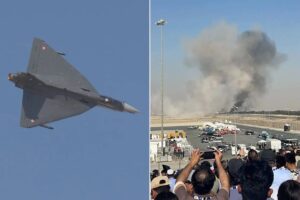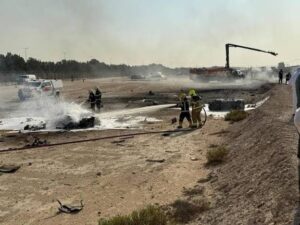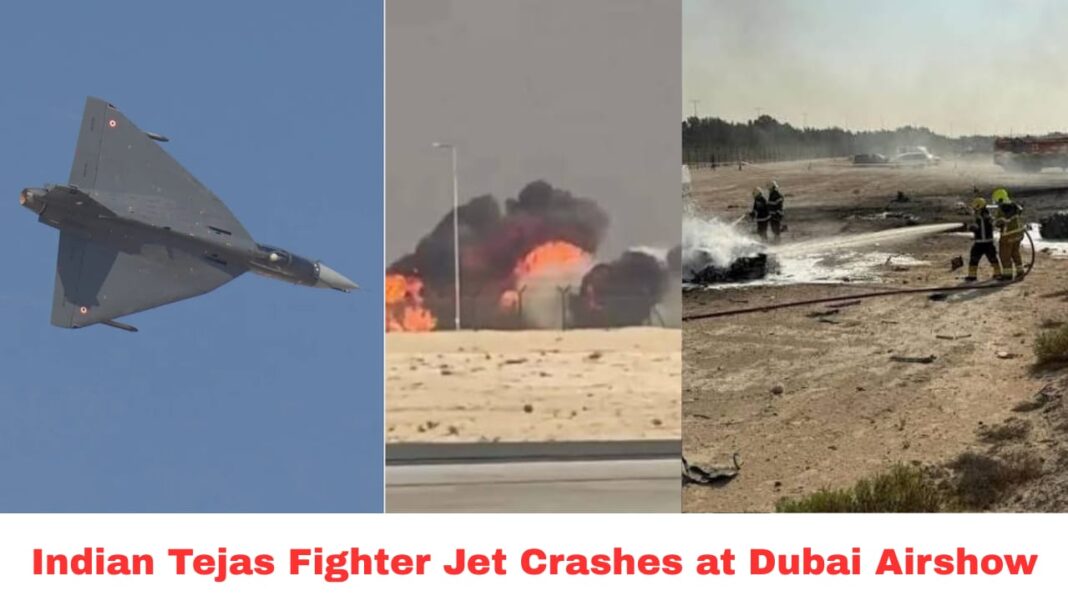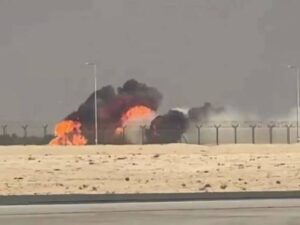Digital News Guru National Desk:
Tragedy at the Dubai Airshow: India’s Indigenous Tejas Fighter Jet Crashes
In a deeply tragic incident, an Indian HAL Tejas light combat aircraft crashed on 21 November 2025 during a demonstration flight at the Dubai Airshow, leading to the death of its pilot. The accident has cast a somber shadow over the grand finale of one of the world’s biggest aviation exhibitions.
The Crash: What Happened
The Tejas jet, operated by the Indian Air Force (IAF), went down at about 2:10 pm local time while performing aerobatic maneuvers over Al Maktoum International Airport. Eyewitness videos and media reports suggest that the aircraft, flying at relatively low altitude, suddenly lost control and plunged toward the ground, erupting in a massive fireball on impact. Thick black smoke rose from the crash site, triggering an immediate response from on-site emergency personnel.

The IAF confirmed that the pilot sustained fatal injuries in the accident. “An IAF Tejas aircraft met with an accident … The pilot sustained fatal injuries in the accident,” the force said in its statement, adding that it “deeply regrets the loss of life and stands firmly with the bereaved family.”
A court of inquiry has been ordered to investigate the exact cause of the crash.
Pilot and Reaction
Authorities have identified the pilot as Wing Commander Namansh Syal, 37, a native of Himachal Pradesh. The Chief Minister of Himachal Pradesh, Sukhvinder Singh Sukhu, publicly expressed his condolences, calling the incident a “deep loss” for the armed forces and for the nation.
The IAF’s reaction has been solemn and immediate, expressing “deep grief” and acknowledging the tremendous risk personnel face even during peacetime. In parallel, the Dubai Media Office also confirmed that firefighting teams rushed to the scene, and that emergency services managed the situation swiftly.
Technical and Contextual Significance
The Tejas is not just any aircraft — it is India’s indigenously developed lightweight multi-role fighter, built by Hindustan Aeronautics Limited (HAL) in collaboration with the Aeronautical Development Agency (ADA). The jet represents a key component of India’s “Make in India” defense manufacturing push, intended to reduce reliance on imported fighters.
This crash marks only the second serious accident involving a Tejas. The first occurred in March 2024 near Jaisalmer, when another Tejas went down during a training sortie, though that time the pilot ejected safely.

Analysts note with concern that the Tejas Mk-1 is still being widely used by the IAF. Meanwhile, the upgraded Tejas Mk-1A, which features advanced systems like an AESA radar, an electronic warfare suite, and beyond-visual-range (BVR) missile capability, is still awaiting full deployment.
Aftermath at the Airshow
The crash caused a temporary suspension of the aerial display at the Dubai Airshow. Spectators, including families, were visibly shocked; panic spread as the fire and smoke billowed. After about 45 minutes, flight demonstrations resumed, though the atmosphere had clearly changed.
Broader Implications
The incident has several implications for India’s defense and aviation strategy:
- Safety & Reliability Concerns
A crash during an airshow — especially of an indigenous jet — raises serious questions about flight safety, pilot training, and aircraft reliability. Given that the Tejas is a key part of India’s future air power, such incidents could slow down confidence in its broader operational and export potential. - Impact on “Make in India” Vision
The Tejas is often presented as a symbol of India’s push for self-reliance in defense manufacturing. A high-profile crash can damage the narrative, especially when the world’s defense stakeholders are watching. It could also complicate foreign orders and collaborations. - Urgency for Investigation
The court of inquiry launched by the IAF will be critical. Its findings could influence not only internal safety protocols but also future design decisions, especially for the Mk-1A variant. - Public & Military Morale
Losing a pilot in such a public demonstration is a blow to morale — both within the armed forces and among the public. The pilot’s identity, bravery, and sacrifice are likely to become focal points in how the IAF handles the aftermath. - Airshow Risk Management
The crash highlights the inherent risk of aerobatic displays. Airshows by definition involve complex and risky maneuvers at low altitudes. Organizers and participating militaries may now reassess their risk management protocols for demonstration flights.
Conclusion
The crash of the HAL Tejas fighter jet at the Dubai Airshow is a tragic event that resonates on multiple levels — emotionally, technologically, and strategically. For India, it is a moment of mourning, but also one of introspection: how to ensure that its prized indigenous fighter not only embodies national ambition but also meets the highest standards of safety and reliability.
As the IAF inquiry unfolds, all eyes will be on the lessons it draws, and on how India’s defense establishment responds — not just to console a grieving family, but to secure the future of a program that represents much more than a single aircraft.
You May Also Read: India Implements Four Labour Codes, Replacing 29 Laws









